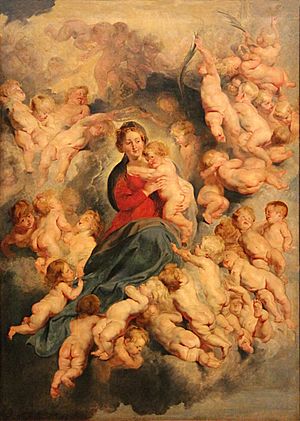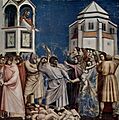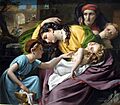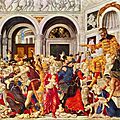Massacre of the Innocents facts for kids
The Massacre of the Innocents is a story from the Gospel of Matthew in the Bible. It tells how Herod the Great, the king of Judea, ordered all baby boys aged two and under in and around Bethlehem to be killed. He did this because he was afraid of a new "king of the Jews" being born.
The Catholic Church sees these children as the first Christian martyrs. A martyr is someone who dies for their faith. Their special day, called Holy Innocents' Day or the Feast of the Holy Innocents, is celebrated on December 28. Many historians and Bible experts believe this event is more of a story or legend than a true historical event.
Quick facts for kids Holy Innocents |
|
|---|---|

The Virgin and Child Surrounded by the Holy Innocents by Peter Paul Rubens
|
|
| First Martyrs | |
| Born | Various, presumably close to the birth of Jesus Bethlehem, Judea |
| Died | c. 7–2 BC Bethlehem, Judea (martyred by King Herod the Great) |
| Venerated in | |
| Canonized | Pre-Congregation |
| Feast |
|
| Attributes | Martyr's palm Crown of martyrdom |
| Patronage |
|
| Major events in Jesus's life in the Gospels |
|---|
|
Contents
The Story in the Bible
The Gospel of Matthew tells us that wise men, called the Magi, came to Jerusalem. They were looking for the newborn king of the Jews. King Herod told them to go to Bethlehem. He asked them to report back to him after they found the child.
However, the Magi were warned in a dream not to return to Herod. They learned that Herod wanted to find and kill the child. So, they went home another way.
Matthew's Gospel then says:
When Herod realized that he had been tricked by the Magi, he was furious. He ordered all the boys in Bethlehem and nearby areas who were two years old or younger to be killed. This was based on the time he had learned from the Magi.
After this, the Bible mentions a prophecy from the Book of Jeremiah. It says, "A voice is heard in Ramah, weeping and great mourning. Rachel weeps for her children and refuses to be comforted, because they are no more." (Matthew 2:17-18).
History and Meaning
The story of the massacre is only found in Matthew's Gospel. It is not mentioned in other historical writings from that time. For example, Josephus, a historian who wrote about Herod, did not record this event. Because of this, many scholars believe the story is more of a legend. It might have been inspired by Herod's reputation for being cruel.
The author of Matthew's Gospel might have based this story on an older Bible story. This is the story of Pharaoh trying to kill Israelite children in the Book of Exodus. In that story, Moses is saved from Pharaoh's orders. Later, like Jesus, Moses has to flee and returns when those who wanted to kill him are gone.
The story of the massacre helps Matthew's wider story about Jesus. It shows that the coming of the Messiah (Jesus' birth) was first rejected by some (Herod). But then, it was accepted by others (the Magi, who were not Jewish).
How Many Children?
The exact number of children killed is not known. Different ancient texts give very different numbers. Some Greek texts say 14,000 children. Some Syrian lists say 64,000. Coptic sources even claim 144,000 children.
However, Bethlehem was a small town. Modern scholars believe the actual number would have been much smaller. It was likely between six and twenty children in the town itself. A few more might have been killed in the surrounding areas.
The Massacre in Art
The story of the Massacre of the Innocents has inspired many artists. It has been shown in plays, songs, and paintings.
Medieval plays, called liturgical drama, often told Bible stories. These included Herod's killing of the innocents. The famous Coventry Carol is a Christmas song from the 16th century. It was part of a play performed in Coventry, England. The song is a sad lament from a mother whose child is taken. It is the only carol from that play that we still have today.
Many famous painters have created artworks about this event. Guido Reni painted his Massacre of the Innocents in 1611. The Flemish painter Peter Paul Rubens painted the scene more than once. His grand Massacre of the Innocents is now in Toronto, Canada. The French painter Nicolas Poussin also painted The Massacre of the Innocents in 1634.
The story has also appeared in books and films. For example, the 2006 film The Nativity Story begins with this event.
Feast Day
The special day for the Holy Innocents is called Holy Innocents' Day. It is also known as the Feast of the Holy Innocents or Childermas. It is a day to remember the children killed by Herod.
This feast day first appeared in the Western church around the year 485. It was often connected with the Feast of the Epiphany on January 6.
Today, the date of Holy Innocents' Day varies:
- December 27 for West Syrians (like the Syriac Orthodox Church).
- December 28 for the Catholic Church, Lutheran Church, and Church of England. In these churches, it is the fourth day of Christmastide.
- December 29 for the Eastern Orthodox Church.
- January 10 for East Syrians (like the Chaldeans).
In the Middle Ages, especially in Europe, this day was sometimes a festival of "inversion." Children and adults would switch roles. For example, "boy bishops" would lead some church services. Some people believed it was an unlucky day, so they would not start new projects.
In Spain, Hispanic America, and the Philippines, December 28 is still a day for pranks. It is similar to April Fool's Day in other countries. These pranks are called inocentadas, and the victims are called inocentes.
In Trinidad and Tobago, Roman Catholic children have their toys blessed at a special Mass on this day.
Images for kids
-
Giotto, Massacre of the Innocents
-
Pieter Brueghel the Elder, Massacre of the Innocents
-
Jacopo Tintoretto, Massacre of the Innocents
-
The scream from Ramah, 2001 stamp of the Faroe Islands
-
Triumph of the Innocents by William Holman Hunt
-
10th-century illuminated manuscript
See also
 In Spanish: Matanza de los Inocentes para niños
In Spanish: Matanza de los Inocentes para niños
- Chapel of the Milk Grotto
- Church of the Nativity § Tombs
- Coventry Carol
- Flight into Egypt
- Jesus and Messianic prophecy § Jeremiah 31:15
- Star of Bethlehem









